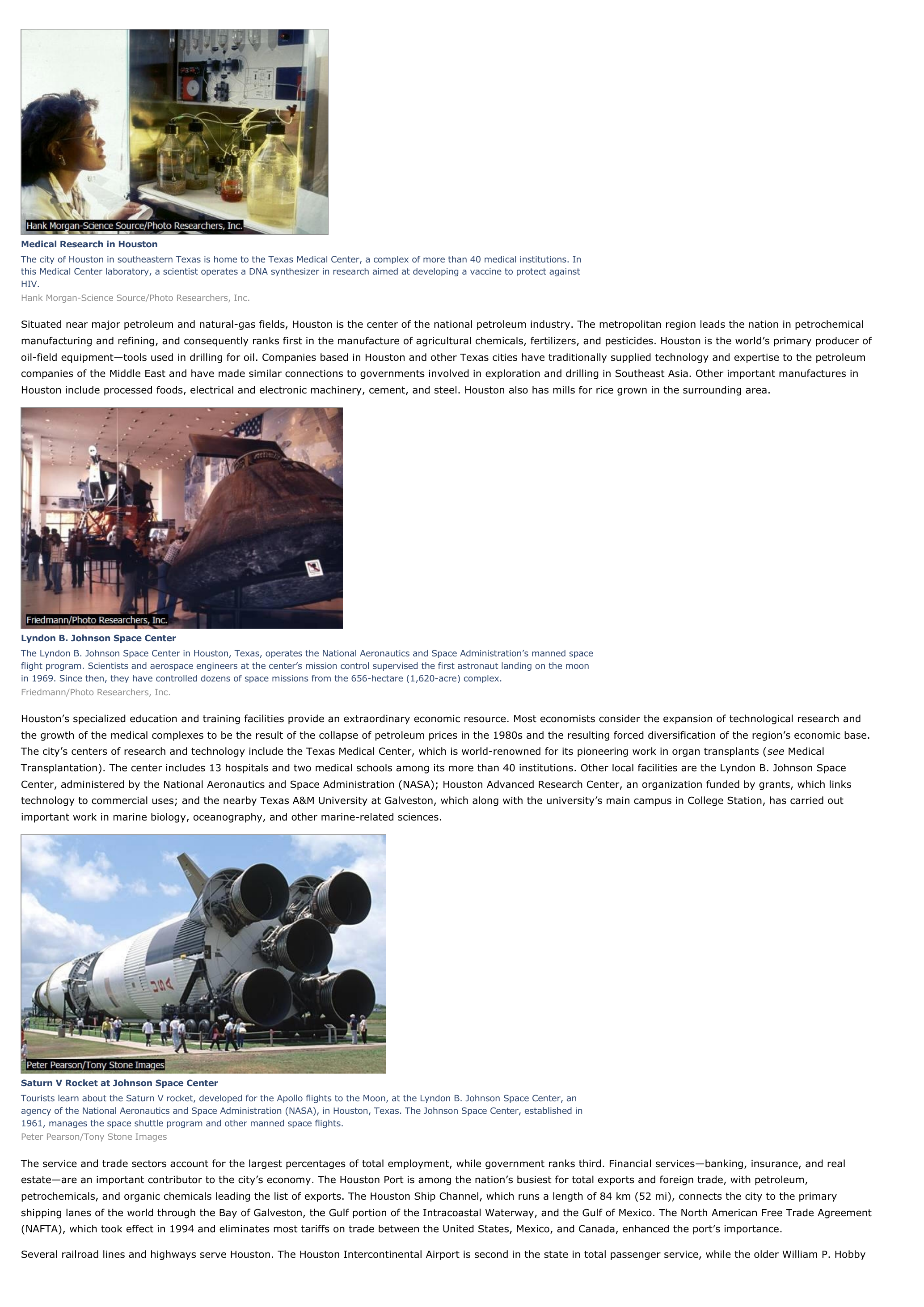Houston - geography.
Publié le 27/05/2013

Extrait du document
«
Medical Research in HoustonThe city of Houston in southeastern Texas is home to the Texas Medical Center, a complex of more than 40 medical institutions.
Inthis Medical Center laboratory, a scientist operates a DNA synthesizer in research aimed at developing a vaccine to protect againstHIV.Hank Morgan-Science Source/Photo Researchers, Inc.
Situated near major petroleum and natural-gas fields, Houston is the center of the national petroleum industry.
The metropolitan region leads the nation in petrochemicalmanufacturing and refining, and consequently ranks first in the manufacture of agricultural chemicals, fertilizers, and pesticides.
Houston is the world’s primary producer ofoil-field equipment—tools used in drilling for oil.
Companies based in Houston and other Texas cities have traditionally supplied technology and expertise to the petroleumcompanies of the Middle East and have made similar connections to governments involved in exploration and drilling in Southeast Asia.
Other important manufactures inHouston include processed foods, electrical and electronic machinery, cement, and steel.
Houston also has mills for rice grown in the surrounding area.
Lyndon B.
Johnson Space CenterThe Lyndon B.
Johnson Space Center in Houston, Texas, operates the National Aeronautics and Space Administration’s manned spaceflight program.
Scientists and aerospace engineers at the center’s mission control supervised the first astronaut landing on the moonin 1969.
Since then, they have controlled dozens of space missions from the 656-hectare (1,620-acre) complex.Friedmann/Photo Researchers, Inc.
Houston’s specialized education and training facilities provide an extraordinary economic resource.
Most economists consider the expansion of technological research andthe growth of the medical complexes to be the result of the collapse of petroleum prices in the 1980s and the resulting forced diversification of the region’s economic base.The city’s centers of research and technology include the Texas Medical Center, which is world-renowned for its pioneering work in organ transplants ( see Medical Transplantation).
The center includes 13 hospitals and two medical schools among its more than 40 institutions.
Other local facilities are the Lyndon B.
Johnson SpaceCenter, administered by the National Aeronautics and Space Administration (NASA); Houston Advanced Research Center, an organization funded by grants, which linkstechnology to commercial uses; and the nearby Texas A&M University at Galveston, which along with the university’s main campus in College Station, has carried outimportant work in marine biology, oceanography, and other marine-related sciences.
Saturn V Rocket at Johnson Space CenterTourists learn about the Saturn V rocket, developed for the Apollo flights to the Moon, at the Lyndon B.
Johnson Space Center, anagency of the National Aeronautics and Space Administration (NASA), in Houston, Texas.
The Johnson Space Center, established in1961, manages the space shuttle program and other manned space flights.Peter Pearson/Tony Stone Images
The service and trade sectors account for the largest percentages of total employment, while government ranks third.
Financial services—banking, insurance, and realestate—are an important contributor to the city’s economy.
The Houston Port is among the nation’s busiest for total exports and foreign trade, with petroleum,petrochemicals, and organic chemicals leading the list of exports.
The Houston Ship Channel, which runs a length of 84 km (52 mi), connects the city to the primaryshipping lanes of the world through the Bay of Galveston, the Gulf portion of the Intracoastal Waterway, and the Gulf of Mexico.
The North American Free Trade Agreement(NAFTA), which took effect in 1994 and eliminates most tariffs on trade between the United States, Mexico, and Canada, enhanced the port’s importance.
Several railroad lines and highways serve Houston.
The Houston Intercontinental Airport is second in the state in total passenger service, while the older William P.
Hobby.
»
↓↓↓ APERÇU DU DOCUMENT ↓↓↓
Liens utiles
- Houston - geography.
- Hughes Howard Robard, 1905-1976, né à Houston (Texas), homme d'affaires, producteur et cinéaste américain.
- Houston.
- whitney houston
- WNBA Champions Season Winner Series Loser 1997 Houston Comets 1-0 New York Liberty 1998 Houston Comets 2-1 Phoenix Mercury 1999 Houston Comets 2-1 New York Liberty 2000 Houston

































